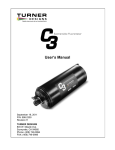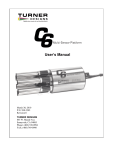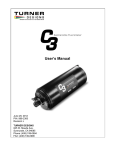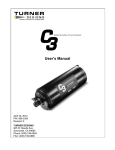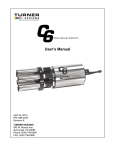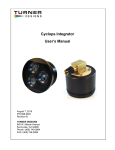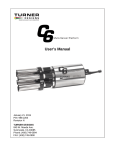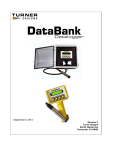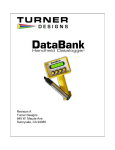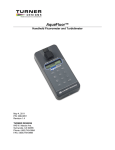Download 998-2300 Revision E TURNER DESIGNS 845 W. Maude Ave
Transcript
May 5, 2010 P/N: 998-2300 Revision E TURNER DESIGNS 845 W. Maude Ave. Sunnyvale, CA 94085 Phone: (408) 749-0994 FAX: (408) 749-0998 C3 Submersible Fluorometer Table of Contents Table of Contents ................................................................................................................................... 2 1.0 Introduction ............................................................................................................................. 5 2.0 Inspection and Setup ........................................................................................................................ 6 2.1 Instrument Checklist.................................................................................................................... 6 2.2 Optional Accessories ................................................................................................................... 7 2.3...................................................................................................................................................... 9 Identification ..................................................................................................................................... 9 3.0 C-Soft Windows User Interface .................................................................................................... 9 3.1 Software Installation and PC Requirements ................................................................................ 9 3.1.1 Minimum PC Requirements........................................................................9 3.1.2 Software Installation ...................................................................................9 3.1.3 PC Software Interface ...............................................................................10 3.2 Software Operation.................................................................................................................... 10 3.2.1 Settings Screen ..........................................................................................10 3.2.2 Current Data and Calibration Screen.........................................................11 Current Data ...................................................................................................11 Tabular Screen................................................................................................12 Waveform Screen ...........................................................................................12 Calibration Screen ..........................................................................................13 Direct Concentration Mode ............................................................................14 Raw Fluorescence Mode Blank Subtracted ...................................................14 Raw Fluorescence Mode ................................................................................14 3.2.2.1 Direct Concentration Calibration ...........................................................14 Step 1: Blanking .............................................................................................14 Step 2: Standard Value and Units ..................................................................14 Step 3: Set Standard .......................................................................................15 Step 4: Optional Temperature Compensation ................................................15 Step 5: Save Calibration.................................................................................15 3.2.2.2 Raw Fluorescence Calibration – Blank Subtracted................................15 Step 1: Blanking .............................................................................................15 Step 2: Selecting Units ...................................................................................16 Step 3: Skip and go to Step 4 .........................................................................16 Step 4: Optional Temperature Compensation ................................................16 Step 5: Save Calibration.................................................................................16 3.2.2.3 Raw Fluorescence Calibration ...............................................................16 3.2.2.4 Depth Calibration (Optional Accessory)................................................16 Atmospheric Offset ........................................................................................16 Atmospheric and Gravity Offset ....................................................................17 3.2.3 Log Setup Screen ......................................................................................17 3.2.4 Downloading and File Management .........................................................18 3.3 Enabling Data Output Ready State ........................................................................................... 19 C-Series Analog Adapter ...............................................................................20 Integration Cable for Digital (ASCII) Output ................................................20 C3 Submersible Fluorometer 3.3.1 How to setup Hyperterminal for Digital (ASCII) Data Capture ...............20 4.0 Deployment & Accessories............................................................................................................. 23 4.1 Connecting the Submersible Battery Pack ................................................................................ 23 4.2 Battery Bracket Installation ....................................................................................................... 23 4.3 Installing the Mechanical Wiper................................................................................................ 23 Benefits...........................................................................................................24 Installation ......................................................................................................24 4.4 Installing the Flow Cap ............................................................................................................. 24 Installation ......................................................................................................25 Using the Flow Cap as a Calibration Cup ......................................................25 4.5 Using the Secondary Solid Standard ......................................................................................... 26 Installing the Secondary Standard..................................................................26 Important Note Regarding Use of Fluorescein Sensor .................................................................... 27 5.0 Maintenance and Warranty............................................................................................................ 28 5.1 Maintenance .............................................................................................................................. 28 5.1.1 Rinsing ......................................................................................................28 5.1.2 Care for the bulkhead connector ...............................................................28 5.2 Terms......................................................................................................................................... 28 5.3 Warranty Service ....................................................................................................................... 28 5. 3.1 Out-of-Warranty Service..........................................................................29 Appendix A. C3 Submersible Fluorometer Specifications.................................................................... 31 Appendix B. C3 Submersible Fluorometer Operating Instructions...................................................... 32 Identification ..................................................................................................32 Appendix C. C3 Submersible Fluorometer Wiring Guide.................................................................... 33 C3 Submersible Fluorometer bulkhead and serial port connectors................33 Appendix D. Solid Secondary Standard ............................................................................................... 34 C3 Submersible Fluorometer Equipment Specified as Electrical and Electronic Waste C3 Submersible Fluorometer 1.0 Introduction The C3 Submersible Fluorometer is manufactured according to user’s optical specifications with one, two, or three optical sensors ranging in wavelengths from ultra violet to infrared. Each optical sensor is designed with a static excitation and emission filter. The C3 Submersible Fluorometer comes with a factory installed temperature probe and can be configured with a pressure sensor for depth measurements up to 600 meters and/or a wiper motor to minimize biofouling during extended or short-term deployments. The C3 Submersible Fluorometer Windows based user interface allows for easy calibration of each sensor, digital data reporting, data logging, file downloading, and digital or analog export of data. Available Optical Sensors: Turbidity In Vivo Chlorophyll a Blue Green Algae (Phycoerythrin) Blue Green Algae (Phycocyanin) CDOM Crude Oil Refined Oils and Fuels Fluorescein (See important note on page 25) Rhodamine Dye Optical Brighteners Custom Optics 998-2300 Rev. E Page 5 C3 Submersible Fluorometer 2.0 Inspection and Setup 2.1 Instrument Checklist The C3 Submersible Fluorometer package (P/N: 2300-000) includes: C3 Submersible Fluorometer Factory installed temperature sensor Interface cable for communicating with your PC and supplying power to the instrument CD includes C-Soft software, user’s manual, and quick start guide Temperature Sensor 12V power supply Computer interface cable 998-2300 Rev. E Page 6 C3 Submersible Fluorometer 2.2 Optional Accessories Pressure sensor (P/N: 2300-360) Factory installed C3 Mechanical Wiper (P/N: 2300-450) Factory installed (Note: The Pressure sensor and mechanical wiper can only be installed during the manufacturing of the unit) Replaceable Brush (P/N: 2200-460) Submersible Battery Kit includes charger (P/N: 2200-601) C3 Submersible Battery Bracket (P/N: 2300-603) Flow Cap (P/N: 2300-700) Shade Cap (P/N: 2300-500) Shade Cap Weight (P/N: 2300-510) Booster Kit (P/N: 2200-900) (Note: Required for cable lengths greater than 10 meter). Extended Cables: 10 meters (P/N: 105-2595) 25 meters (P/N: 105-2596) 50 meters (P/N: 105-2597) Custom lengths available upon request Secondary solid standard (P/N: 2300-900) for multiple sensors (Note: Not available for turbidity or ultraviolet sensors) C-Series Analog Adapter (P/N: 2300-480) Integration Cable (P/N: 2200-160) (Note: Only used for continuous data output, not intended for communication with C3) Mechanical Wiper 998-2300 Submersible Battery Rev. E Page 7 C3 Submersible Fluorometer Battery Bracket Flow Cap Shade Cap Booster Kit Solid Standard Insert Secondary Solid Standard 998-2300 Rev. E Page 8 C3 Submersible Fluorometer 2.3 Identification Sensors are marked with numbers 1, 2, or 3 located adjacent to the optics on the face of the C3 Submersible Fluorometer. These numbers correspond to channels 1, 2, and 3 in C-Soft (C3 software). Note: Channel names can be modified using C-Soft. Light emitting diode color table. Application Chlorophyll a Turbidity Phycocyanin Phycoerythrin Fluorescein Rhodamine CDOM Refined Oils and Fuels Crude Oil Optical Brighteners Light Source Color Blue Infra Red (No Color) Yellow Green Blue (See important note on page 25) Green Ultra Violet (No Color)* Ultra Violet (No Color)* Ultra Violet (No Color)* Ultra Violet (No Color)* *Do not look directly onto the optics. Ultraviolet light can be damaging to the eyes. 3.0 C-Soft Windows User Interface The C-Soft Windows based user interface allows for intuitive calibration, data logging set up, and download functions. 3.1 Software Installation and PC Requirements 3.1.1 Minimum PC Requirements 133MHz microprocessor 600 X 800 VGA resolution Microsoft Windows 98 32 MB RAM 3.1.2 Software Installation 1. Exit all Windows programs 2. Insert the C-Soft CD (also located on the Turner Designs Software web page, http://www.turnerdesigns.com/t2/sw/main.html). 3. Open the C-Soft software folder and double click on the setup icon. 4. The software will automatically be installed in the PC’s (C:/Program Files/C-Soft) folder unless user selects alternate location. 998-2300 Rev. E Page 9 C3 Submersible Fluorometer 5. After restarting the PC double click on the "C-Soft" icon located on the desktop. C-Soft Note: You may receive a warning message asking if you want to unblock messages, select "Unblock" 3.1.3 PC Software Interface 1. Connect the 9-pin serial end of the interface cable to the serial port on the back of the PC. Note: If your computer only has USB ports we recommend purchasing a USB to serial adapter cable. (See Turner Designs Support web page for recommendations) 2. Connect the 8-pin female end of the interface cable to the C3 Submersible Fluorometer’s 8-pin male connector. 3. Connect the interface cable’s 12V pin to the 12V power supply. 4. Plug the 12V power supply into a power source. 5. Wait for initialization process to complete. The connection icon, located on the upper right of the screen, will turn green if connected. Note: If the connection icon does not turn green disconnect and reconnect power. 3.2 Software Operation 3.2.1 Settings Screen The Settings Screen allows users to set the time and date, identify each optical sensor, update serial numbers, and enable/disable sensors. Users can manually set the date and time or choose to synchronize the C3 Submersible Fluorometer to the PC date and time. Each channel (1-3) in the Settings Screen has a location associated with it on the C3 Submersible Fluorometer that is numerically labeled (1-3), respectively. Channels 4-6 are designated for the C6 Multi-Sensor Platform. 998-2300 Rev. E Page 10 C3 Submersible Fluorometer Click on the box adjacent to the channel to enable channel operation. If there is no sensor installed users will be unable to select that channel. Channels can be renamed using the dropdown selections or by manually entering a name. The serial number boxes are designed for the C6 Multi-Sensor Platform. Settings will automatically be saved after exiting the Settings screen. 3.2.2 Current Data and Calibration Screen The Current Data Screen allows users to view real-time data acquisition, in both tabular and waveform formats, as well as conduct calibrations for each channel. Current Data Channel names are displayed but cannot be changed in the Current Data screen. Real-time values are displayed next to each channel and in the adjacent Data Table. A calibration button is available for each channel and the depth sensor. Real-time data can be saved by selecting the “Start Data Capture” button. Users will be prompted to enter a file name and file location. Data files will be saved in (*.csv) format. 998-2300 Rev. E Page 11 C3 Submersible Fluorometer Tabular Screen Real-time data including time, date, temperature, and units are continuously scrolling on the tabular screen for enabled channels. Channel names will appear in the associated column headings. If units are not selected during calibration, a relative fluorescence units (RFU) label will appear. Waveform Screen Users can graphically view real-time data for each sensor by clicking the “Display Waveform” box. Channel names and units will be displayed on the Y-axis. Time and date will be displayed on the X-axis. Clicking the “Autoscale” box will automatically scale graphs. Data can be saved during waveform mode by clicking “Start Data Capture”. 998-2300 Rev. E Page 12 C3 Submersible Fluorometer Calibration Screen Users can calibrate sensors in either the direct concentration mode, raw fluorescence mode, or blank subtracted raw fluorescence mode. 998-2300 Rev. E Page 13 C3 Submersible Fluorometer Direct Concentration Mode Values reported in the Direct Concentration Mode are scaled to a predetermined standard value and blank subtracted. The equation used to calculate concentrations after calibrating to Direct Concentration Mode is: Standard Value (units) x RFU Response = Concentration (units) Standard RFU Raw Fluorescence Mode Blank Subtracted Values in the Raw Fluorescence Blank Subtracted Mode are noted as RFUB. It is important to note that these values are blank subtracted but are not scaled to a standard; they are relative values. Raw Fluorescence Mode Values in the Raw Fluorescence Mode are referred to as “Relative Fluorescence Units” (RFU). It is important to note that these values are not blank subtracted or scaled to a standard; they are relative values. 3.2.2.1 Direct Concentration Calibration Following steps 1-5 will ensure values are reported as blank subtracted Concentrations in units of choice. See Appendix B for recommended practices. Step 1: Blanking Place the C3 Submersible Fluorometer in a blank solution and ensure the optical head is free from air bubbles. Note: A blank solution is a solution without the fluorophore of interest (i.e. de-ionized water, artificial water, or filtered water) Wait until “Current RFU” readings have stabilized then select the “Set Blank” button to set the blank value. Future measurements for this sensor will be blank subtracted based on the blank recorded during calibration. Step 2: Standard Value and Units Place the C3 Submersible Fluorometer in a standard solution or use a secondary solid standard (see Appendix D for more information on solid standards). Note: Not all sensors can be used with solid standards Enter the known concentration value of the standard solution or solid standard in the “Standard Value” box. If the concentration is not known, enter an arbitrary value. Future measurements will be calculated based on the correlated response to the standard value. Enter manually or select desired units from the dropdown menu. Note: Do not choose or enter “RFUB” if Direct Concentration Mode is used 998-2300 Rev. E Page 14 C3 Submersible Fluorometer Step 3: Set Standard When readings in “Current RFU” box have stabilized, select the “Set Standard” button. Step 4: Optional Temperature Compensation Temperature compensation is optional and allows the user to automatically compensate to the factory installed temperature sensor. Temperature compensation is available for Chlorophyll a and Rhodamine sensors only. Temperature is displayed in degree Celsius. Click on the “Temperature Compensation” box. Select either the Chlorophyll a or Rhodamine from the dropdown menu. Data will now be corrected for temperature fluctuations. The temperature compensation coefficients for each fluorophore are listed in the table below. Fluorophore Coefficient Rhodamine 0.026 per degree C Exponential Chlorophyll a 1.4% per degree C Linear Step 5: Save Calibration After calibration is complete, select “Save Calibration”. Data for the selected sensor will now be calibrated. 3.2.2.2 Raw Fluorescence Calibration – Blank Subtracted Following steps 1-5 will ensure values are reported as Blank subtracted Relative Fluorescence Units (RFUB). See Appendix B for recommended practices. Step 1: Blanking Place the C3 Submersible Fluorometer in a blank solution. Note: A blank solution is a solution without the fluorophore of interest (i.e. de-ionized water, artificial water, or filtered water) Note: Ensure the optical head is free of air bubbles Wait until “Current RFU” readings have stabilized then select the “Set Blank” button to set the blank value. Future measurements for this sensor will be blank subtracted based on the blank response recorded during calibration. 998-2300 Rev. E Page 15 C3 Submersible Fluorometer Step 2: Selecting Units Select RFUB from the units’ dropdown menu. Note: Do not enter a value in the standard value box Step 3: Skip and go to Step 4 Step 4: Optional Temperature Compensation – Follow same steps under the Direct Calibration procedure Step 5: Save Calibration After calibration is complete select “Save Calibration”. Data for the selected sensor will now be in relative fluorescence units and blank subtracted. 3.2.2.3 Raw Fluorescence Calibration In the Current Data screen select the “calibrate” button next to a specific channel. At the bottom of the Calibration Screen, click to use “Uncalibrated Raw Fluorescence Mode”. Data for that channel will be uncalibrated and reported as “Relative Fluorescence Units” (RFU). 3.2.2.4 Depth Calibration (Optional Accessory) Depth is displayed in meters only. There are two calibration options for depth: 1. The first uses only the atmospheric pressure as an offset. This is suitable for any shallow application, including most fresh water applications. 2. The second compensates for gravity variations with latitude, as designed from the UNESCO Technical Papers in Marine Science #44. This method assumes 0C and 35PSU salinity. Atmospheric Offset Step 1 (Method 1): Select the “Calibrate” button for depth in the “Current Data” screen. Pressure in PSI will be displayed in the “Current Pressure” window. After “Current Pressure” readings are stable at desired location select “Set Zero”. 998-2300 Rev. E Page 16 C3 Submersible Fluorometer Step 2 (Method 1): Select “Atmospheric offset only”. Step 3 (Method 1): Select “Save Calibration” button. Future depth values will be scaled to the offset. Atmospheric and Gravity Offset Step 1 (Method 2): Select the “Calibrate” button for depth in the “Current Data” screen. Pressure in PSI will be displayed in the “Current Pressure” window. After “Current Pressure” readings are stable, at desired location, select “Set Zero”. Step 2 (Method 2): Select “Atmospheric and gravity offset”. Enter the latitude. Step 3 (Method 2): Select “Save Calibration” button. Future depth values will be scaled to the offset. 3.2.3 Log Setup Screen The Log Setup screen allows the user to configure a logging session, activate the mechanical wiper, and enable logging. The C3 Submersible Fluorometer can log just over 64,000 lines of data. Enter a log start date (MM/DD/YYYY) and time (HH:MM:SS). Enter the sampling interval (HH:MM:SS). The minimum sampling interval is 1 second. If the mechanical wiper is installed click the “Wiper” box to enable. Select the number of revolutions from the dropdown box (1-10 revolutions). All sensors will be wiped at specified revolutions before each measurement. 998-2300 Rev. E Page 17 C3 Submersible Fluorometer Note: If users select revolutions that exceed sampling interval a warning message will be displayed Note: Do not click the Wiper Box to enable wiper if the wiper is not installed After log set up is complete select “Enable Datalog” (see section 3.3 “Enabling Data Output Ready State). A prompt will appear asking if user is ready to enable logging, select “Yes”. Note: If data logging is set to start immediately, there will be a minimum delay of 100 seconds before startup after power has been supplied WARNING! As soon as data logging is enabled users will be unable to access C-Soft settings. This should be the last step before the C3 Submersible Fluorometer is deployed. 3.2.4 Downloading and File Management Users can download new and exisiting files saved in the C3 Submersible Fluorometer memory. Select Download Data. Note: This step may take up to 10 minutes depending on file size When download has completed choose the files to be saved by clicking the “Save” box. Users will be prompted to choose a folder location where data will be saved. Files will be saved in .csv format. Select “Clear Datalog” to erase existing data from memory. 998-2300 Rev. E Page 18 C3 Submersible Fluorometer Users are able to graphically view downloaded data using C-Soft software if desired. 3.3 Enabling Data Output Ready State Users interested in integrating the C3 Submersible Fluorometer into CTDs or Third Party Platforms must enable the C3’s Data Output Ready State using C-Soft Software. There are five necessary steps to ensure the instrument is properly setup for data output: 1) Set the instrument’s clock to PC or local time in the Settings Tab 2) Select the sensors you expect to use during sampling 3) Calibrate selected sensors for either Direct Concentration Mode or Raw Fluorescence Units Blanked (RFUB) Mode (see section 3.2.2.2) 4) Set the start time, sampling, and wiping intervals in the Log Setup Tab. Note: wiping interval is optional and depends on the sampling interval (see section 3.2.3) 5) Click the ‘Enable Datalog’ button followed by the ‘Yes’ button to enable the Data Output Ready State A few seconds after the ‘Yes’ button has been clicked to enable the Data Output Ready State, the C-Soft program will automatically shut down and users must disconnect power and serial connections. The instrument is now in the Data Output Ready State and will 998-2300 Rev. E Page 19 C3 Submersible Fluorometer remain in that state so long as C-Soft is not used to communicate with the instrument. Note: As soon as C-Soft is used to communicate with the instrument, users will need to re-set the parameter settings in the Log Setup (section 3.2.3) and again enable datalog to put the instrument into the Data Output Ready State. When power is supplied to the instrument while it is in the Data Output Ready State, it will begin streaming data after a 100 second delay. If power is cycled (i.e. disconnected and reconnected) please allow 100 seconds for the data stream to begin. The C3 Submersible Fluorometer’s standard output is in digital (ASCII) format. If the CSeries Analog Adapter accessory is used the adapter will convert the standard digital (ASCII) data output to analog voltage data output for integration with instruments or dataloggers that will accept a 0-5 volt signal. C-Series Analog Adapter The C-Series Analog Adapter (PN: 2300-480) allows users to convert the standard digital output from the C3 to a 0 - 5 VDC analog signal for 1, 2, or 3 channels installed on a C3 Submersible Fluorometer. The voltage output is proportional to the fluorescence intensity measured by the sensors. The C-Series Analog Adapter is modeled after the C3’s Submersible Battery Pack and is designed to connect directly to the C3. The C3’s Battery Bracket (PN: 2300-603) is required to hold the C-Series Analog Adapter in place and secure it, preventing any break in communication or power. The C-Series Analog Adapter comes with installation and calibration instructions and customers may download these instructions from the following website: http://www.turnerdesigns.com/t2/doc/Instructions/998-2250.pdf Integration Cable for Digital (ASCII) Output The Integration Cable is recommended for digital integrations with CTDs or Third Party Platforms. This cable is designed so that flow control is disabled; therefore it may only be used for integrations and cannot be used for communicating with the C3. As long as the C3 is in the Data Output Ready State, power is supplied to the instrument, and a 100 second delay has been allowed, the C3 will output digital data continuously without interruptions if the integration cable is used. Using any other cable for digital integrations may cause interruptions caused by hardware flow control. The Integration Cable has 3 connectors: 1) A serial DB9 plug (RS232) 2) A female plug for supplying power to the instrument 3) An 8-pin female connector for connecting to the C3 And can be ordered in either a 2 foot (PN: 2200-160) or 5 meter (PN: 2200-165) cable length. Note: The Integration Cable will have a yellow band which distinguishes it from the standard Interface Cable used to communicate with the C3 Submersible Fluorometer. 3.3.1 How to setup Hyperterminal for Digital (ASCII) Data Capture 1. On an MS Windows computer, open the HyperTerminal program (StartAll ProgramsAccessoriesCommunications HyperTerminal) 2. The Connection Description screen will appear. Name the connection description. This file will save the communication parameters for the C3 Submersible Fluorometer and can be used in the future to establish communication with the instrument quickly. 998-2300 Rev. E Page 20 C3 Submersible Fluorometer 3. The Connect To screen will appear. Choose the appropriate communications port in the Connect Using window. Click OK. 4. The Port Settings screen will appear. Choose the following port settings; Bits per second: 9600 Data bits: 8 Parity: None Stop bits: 1 Flow control: Hardware Click Apply and OK 5. Next, the HyperTerminal window will appear. You are now ready to connect the C3 Submersible Fluorometer to a power source. Data will be displayed at set intervals, in the HyperTerminal window, after 100 seconds or at the specified log start time. Most applications will integrate streaming data. Below are instructions on how to save streaming data on a PC. 998-2300 Rev. E Page 21 C3 Submersible Fluorometer To save data: 1. On the HyperTerminal window toolbar, choose Transfer and then Capture Text 2. When you click on Capture Text, a window will appear asking you to name and save the .txt file to the location of interest. 3. Once you are finished, you will need to return to the HyperTerminal window toolbar, choose Transfer and then Capture Text and select Stop. This will stop data capture to the .txt file. 998-2300 Rev. E Page 22 C3 Submersible Fluorometer 4.0 Deployment & Accessories 4.1 Connecting the Submersible Battery Pack The Battery Pack comes with a charger. There is also an optional 12-inch cable (P/N: 1052590) that is not needed if the battery bracket is installed. The battery is fully charged after 8 hours. Once the Data Output Ready State is enabled attach the battery to the C3 Submersible Fluorometer with the 12-inch cable or via battery bracket. Secure C3 Submersible Fluorometer and battery to a fixed structure. Data logging will begin after a 100 second delay or at specified time and date. Note: The battery is rated for 10,000 data lines, each data line can range from 3-6 data points 4.2 Battery Bracket Installation The Battery Bracket was designed for easy self-contained compact deployment of the C3 Submersible Fluorometer. 1. Align the stainless steel pin on the battery bracket with the associated pinhole on the C3 Submersible Fluorometer. 2. Apply pressure until the battery bracket is firmly attached the C3. 3. Thread the green plastic support line through the holes on the side of the bracket. Green Line 4. The line should be flush with the ends of the support line holes on the bracket. 5. Slip the battery through the bracket and line up the 8-pin end of the battery with the port on the C3. 6. Apply pressure until the battery is firmly attached to the C3. 7. Use an Allen wrench to tighten the bracket so it will grip the end of the battery. 4.3 Installing the Mechanical Wiper The C3 Submersible Fluorometer’s mechanical wiper is an optional accessory that minimizes biofouling during extended deployments. The wiper uses non-destructive brush material to clean the optics allowing for accurate readings under extreme biofouling conditions. Users are able to select the number of wiper rotations before sampling. 998-2300 Rev. E Page 23 C3 Submersible Fluorometer Benefits Limits debris and biofouling organisms from interfering with readings Easy brush replacement design Adjustable wiping revolutions Installation 1. Place the brush assembly on the motor shaft of the C3 Submersible. 2. Center the wiper brush between two of the sensors. 3. Hand tighten the wiper nut clockwise to lock the brush assembly into position and make sure not to over tighten. 4. Open the C-Soft Windows software. In the Log Setup screen (see section 3.2.3) click the “Test Wiper” button to home the wiper motor. The mechanical wiper will make 1-2 revolutions, setting the wiper motor shaft to its home position. Wiper Nut Motor Shaft Brush Assembly 5. Readjust the wiper brush position by loosening the wiper nut and manually rotating the wiper if necessary. 6. Tighten the wiper nut once the wiper brush repositioned. 7. Click the “Test Wiper” button to ensure wiper will home to that position. 4.4 Installing the Flow Cap The Flow Cap for the C3 Submersible Fluorometer was designed to enable flow through mode and can be configured with other instruments with online flow through systems. The flow cap eliminates the possibility of ambient light interference and it can be used as a calibration cup for holding standard solutions when calibrating optical sensors. The flow cap also offers protection for the optical head during deployment or transportation and will help limit biofouling. The Flow Cap can be installed on C3 Submersible Fluorometers with or without the mechanical wiper. 998-2300 Rev. E Page 24 C3 Submersible Fluorometer Installation 1. Turning clockwise, fully hand tighten the Flow Cap housing onto the C3 Submersible Fluorometer. The port located on the Flow Cap Housing should be closest to the optical head. 2. Turning clockwise, hand tighten the End Cap onto the Flow Cap Housing until it is fully tightened. Flow Cap Housing End Cap OUT FLOW PORT IN FLOW PORT Note: Turner Designs recommends the following configuration for the Flow Cap (left). For optimal performance, position the instrument vertically with the sensor head facing upward to expel any air from the system that might cause skewed readings. Using the Flow Cap as a Calibration Cup 1. Remove the End Cap. Port Plug 2. Use a port plug to plug the port located on the Flow Cap Housing. 3. Position the unit vertically with optical head facing upward (see diagram to the right). 4. In this position the Flow Cap Housing can be used to hold standard solutions for calibrating the C3 sensors. Note: Make sure to completely fill the Flow Cap with solution and thread on the end cap before taking measurements to ensure a darkened environment thereby minimizing interference. 998-2300 Rev. E Page 25 C3 Submersible Fluorometer 4.5 Using the Secondary Solid Standard The C3 Secondary Solid Standard is designed with a specific filter that provides a stable fluorescent signal that is adjustable. The solid standard can be used in place of a primary liquid standard once a correlation between a primary standard and the solid standard has been established. It can also be used to check the stability of the instrument, and/or check for loss in sensitivity resulting from the growth of bio-fouling organisms on the sensor optics. Installing the Secondary Standard 1. Align Solid Standard Cap numbers with C3 sensor head numbers, then snap the Solid Standard Cap in place. Solid Standard Cap numbers 2. Slightly rotate cap until it is set into position. Note: you will feel/hear a click when cap is positioned. 3. Insert up to 3 Solid Standards into the desired optical port position of the Solid Standard Cap. 4. Rotate the Solid Standards until they set into position. 5. If there is a mechanical wiper it must be removed before using the solid standard. Individual Solid Standard 1. To adjust each solid standard, use the green screwdriver to unscrew the locking nut as far as it will go. Adjustable Locking Screw 998-2300 Rev. E Page 26 C3 Submersible Fluorometer 2. To change the signal level, insert the blade of the green screwdriver through the hole in the locking nut. Rotate it until it engages with the adjustment screw that is beneath the locking nut. 3. The signal can be adjusted to desired reading by turning the screw. Turning the screw clockwise will move the filter closer to the optical head causing an increase in signal. 4. Once the desired reading has been obtained, the locking nut should be screwed down so that the adjustment screw is held firmly in place. Note: The response of every solid standard is unique. Therefore, a new correlation must be determined for every sensor. Use the “ID” space on the Secondary Standard’s label to uniquely identify each Standard. Important Note Regarding Use of Fluorescein Sensor The Fluorescein sensor, when enabled with other sensors, specifically Chlorophyll and Rhodamine sensors, for simultaneous data collection will produce unreliable results. Therefore, the Fluorescein sensor should not be used for simultaneous data collection with Chlorophyll or Rhodamine sensors. All other sensors can be used simultaneously with the Fluorescein sensor. 998-2300 Rev. E Page 27 C3 Submersible Fluorometer 5.0 Maintenance and Warranty 5.1 Maintenance 5.1.1 Rinsing The C3 Submersible Fluorometer should be rinsed or soaked in freshwater following each deployment. 5.1.2 Care for the bulkhead connector Install the 8-pin female end plug to the bulkhead between uses. A light coat of Silicone based grease should be used on the rubber of the male pins of the bulkhead to aid in sealing. 5.2 Terms Turner Designs warrants the C3 and accessories to be free from defects in materials and workmanship under normal use and service for a period of 12 months from the date of shipment from Turner Designs with the following restrictions: Turner Designs is not responsible for replacing parts damaged by accident or neglect. Your instrument must be installed according to instructions in the User’s Manual. Damage from corrosion is not covered. Damage caused by customer modification of the instrument is not covered. This warranty covers only Turner Designs products and is not extended to equipment used with our products. We are not responsible for accidental or consequential damages, except in those states where this limitation is not allowed. This warranty gives you specific legal rights and you may have other rights which vary from state to state. Damage incurred in shipping is not covered. 5.3 Warranty Service To obtain service during the warranty period, the owner shall take the following steps: 1. Write, email or call the Turner Designs Technical Support department and describe as precisely as possible the nature of the problem. Phone: 1 (877) 316-8049 Email: [email protected] 2. Carry out any adjustments or tests as suggested by the Technical Support Department. 3. If proper performance is not obtained you will be issued a Return Materials Authorization number (RMA) to reference. Package the unit, write the RMA number on the outside of the shipping carton, and ship the instrument, prepaid, to Turner Designs. If the failure is covered under the warranty terms, the instrument will be repaired and returned free of charge, for all customers in the contiguous continental United States. 998-2300 Rev. E Page 28 C3 Submersible Fluorometer For customers outside of the contiguous continental United States who purchased equipment from one of our authorized distributors, contact the distributor. If you purchased directly, contact us. We will repair the instrument at no charge. Customer pays for shipping duties and documentation to Turner Designs. Turner Designs pays for return shipment (custom duties, taxes and fees are the responsibility of the customer). 5. 3.1 Out-of-Warranty Service Follow steps for Warranty Service as listed above. If our Technical Support department can assist you by phone or correspondence, we will be glad to, at no charge. Repair service will be billed on a fixed price basis, plus any applicable duties and/or taxes. Shipment to Turner Designs should be prepaid. Your bill will include return shipment freight charges. Address for Shipment: Turner Designs, Inc. 845 W. Maude Ave. Sunnyvale, CA 94085 998-2300 Rev. E Page 29 C3 Submersible Fluorometer Equipment Specified as Electrical and Electronic Waste 998-2300 Rev. E Page 30 C3 Submersible Fluorometer Appendix A. C3 Submersible Fluorometer Specifications C3 Submersible Fluorometer Weight in Air 1.64 kg (3.6 lbs) Length 23 cm (9.1 in.) Diameter 10 cm (3.9 in.) Material Delrin Temperature -2 to 50 degrees C Temperature Accuracy 0.5 degree C Temperature Resolution 0.1 Depth 600 meters External Power 8 to 30 VDC Signal Output Digital (ASCII) or Analog (Note: analog requires accessory) Interface RS232 (USB Adapter) Maximum Sampling Rate 1 second Nonvolatile Memory 64,000 Data Lines Power Draw - Sleep Mode < 1mAmp Power Draw - Max 1 Watt Submersible Battery Pack Battery Lithium-Ion Weight in Air 0.75 kg (1.65 lbs) Weight in Water 0.22 kg (0.50 lbs) Length 13.46 cm (5.3 in.) Diameter 7 cm (2.75 in.) Material Delrin Temperature -2 to 50 degrees C Depth 600 meters Capacity 2,200 mAH Voltage Output 14.8V nominal Protection Features Protects against: overcharge, overheating, short-circuiting 998-2300 Rev. E Page 31 C3 Submersible Fluorometer Appendix B. C3 Submersible Fluorometer Operating Instructions Identification Sensors are labeled 1, 2 or 3 adjacent to the optics on the face of the instrument. Each channel is factory set in the C3 Windows Software. *Note: The channel labels can be modified in the C-Soft software. Light Emitting Diode Color Table Application Chlorophyll a Turbidity Phycocyanin Phycoerythrin Fluorescein Rhodamine CDOM Refined Oils and Fuels Crude Oil Optical Brighteners Light Source Color Blue Infra Red (No Color) Yellow Green Blue Green Ultra Violet (No Color)* Ultra Violet (No Color)* Ultra Violet (No Color)* Ultra Violet (No Color)* *Do not look directly onto the optics. Ultra Violet light can be damaging to the eyes. Recommended Measurement Practices The following steps will improve the accuracy and repeatability of your measurements, especially at low concentration levels: 1. Use a Glass Container for your standards and/or samples. (Note: Avoid plastic beakers – plastic may fluoresce and might interfere with measurements. 2. Place the glass beaker on a non-reflective surface, preferably black. 3. Ensure that the sensor is >3 inches above the bottom of the glass beaker. 4. Ensure that the sensor is in the center of the glass beaker, and has >2 inches clearance between the sensor and the inside surface of the beaker. 5. Check that the optical surface of the sensor is free of air bubbles. Calibrated Sensor >2 inches all round Glass Beaker >3 inches No Air Bubbles On Optical Surface 998-2300 Dark/Black Non-Reflective Surface Rev. E Page 32 C3 Submersible Fluorometer Appendix C. C3 Submersible Fluorometer Wiring Guide The C3 Submersible Fluorometer outputs digital data in three formats: 1) Digital data that can only be read by C3 Submersible Fluorometer’s software, 2) Digital data in ASCII format that can be read by larger multi parameter systems such as CTD’s, and 3) Digital data that can be read and converted to analog data by the C-Series Analog Adapter. An 8-pin impulse cable provides two end connections: 1) a 9-pin RS232 serial port for connection to a PC or laptop computer and 2) a 12V port for supplying power to the unit. C3 Submersible Fluorometer bulkhead and serial port connectors Sub D Connector 8 2 1 7 5 4 3 2 1 3 4 6 9 5 8 7 6 Wire Guide Pin Out Color C3 Function 1 Black V BATT (+) 2 White V BATT (-) 3 4 5 6 7 8 Red Green Blue Brown Yellow Orange GND RX TX DTR & DSR RTS & CTS N/A Corresponding Sub D Connector Pin Power Connector Cable–Center Pin (+) Power Connector Cable– Housing (-) PIN 5 PIN 2 PIN 3 PIN 4, 6 PIN 7, 8 N/A *Power ground and V Batt (-) are not common. 998-2300 Rev. E Page 33 C3 Submersible Fluorometer Appendix D. Solid Secondary Standard Use of the Solid Secondary Standard: The Solid Secondary Standard can be use to: Check signal stability Determine drift Recalibrate 1. To establish a correlation between a known concentration and its respective fluorescence output immerse the sensor in a sample with a known concentration of your fluorophore. 2. Dry off the C3 Submersible Fluorometer’s optics, attach the Solid Standard, and adjust the Solid Standard to produce the same fluorescence output value from the sensor as in step 1, (Note: turning the Secondary Standard adjustment screw clockwise produces a higher signal. 3. Now your Solid Secondary Standard has been correlated to a known concentration and as long as it is no longer adjusted, stored and used properly that signal will remain a stable reference point. 4. Comprehensive information on fluorescence applications can be found at the following website: http://www.turnerdesigns.com/t2/doc/appnotes/main.html#fluorescent Note: There are no Solid Secondary Standards available for the Turbidity or UV optical sensors. 998-2300 Rev. E Page 34 C3 Submersible Fluorometer Linear Range and Quenching The linear range is the concentration range in which the C3 sensor output is directly proportional to the concentration of the signal. The linear range begins with the smallest detectable concentration and spans to an upper limit (concentration) that is dependent upon the properties of the material, filters used, and path length. A non-linear relationship is seen at very high concentrations where the signal does not increase at a constant rate in comparison to the change in concentration, see figure below. At even higher concentrations, the signal will decrease even though the sample concentrations are continuing to increase. This effect is known as “signal quenching”. Linearity can be checked by diluting a sample 1:1 or some other convenient ratio. If the sample is still in the linear range, the reading will decrease in direct proportion to the dilution. If the reading does not decrease in direct proportion to the dilution or if the reading increases, the sample is beyond the linear range. Fluorometer Reading Fluorometer Response Curve Sample Quenching Region Graph showing Linear and Quenching Regions of the sample’s response Sample Linear Region Sample Concentration Temperature Considerations Fluorescence is temperature sensitive. As the temperature of the sample increases, the fluorescence decreases. For greatest accuracy, record the sample temperature and correct the sensor output for changes in temperature. For further information on how temperature, light, water quality and the physiological state of the algal cells can all affect the measurement of chlorophyll a, please refer to the application section of Turner Designs’ web site at the following URL: http://www.turnerdesigns.com/esupport/understanding.html 998-2300 Rev. E Page 35



































